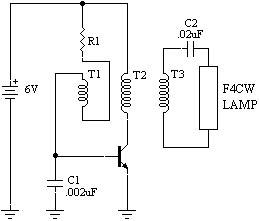With TJ Byers
Flyback Is Back
Question:
I have this little fluorescent light that contains a transformer, one transistor, four caps, two resistors, and runs off four (1.5V) ordinary batteries. I'm trying to learn transistor theory, but this circuit eludes me because the base voltage seems to be wrong. Here are the measured voltages on the transistor using a 6.8-volt supply:
Vc = 6.5V
Vb = 1.14V
Emitter is tied to ground.
Now, my question. This seems like a VERY simple circuit, but I'm just not sure how it works. Is this transistor being used as a switch in what appears to be a flyback transformer? And why is the base voltage 1.14 volts when the textbooks say it's supposed to be 0.7 volts?
Tim
via Internet
Answer:
You're quite right. Your fluorescent light is driven by a flyback circuit. Here's a diagram of one that I bought from a hardware store for about $10.00.

Although this version uses just one resistor and two capacitors, it works the same. Basically, the transformer is the heart of the circuit and the transistor is nothing more than a switch. When power is applied, current flows through the resistor and turns the transistor on, which causes current to flow through the T2 winding of the flyback transformer. This induces a voltage in the T1 winding, which opposes the base current — that is, it tries its best to shut off the base current. At some point, it succeeds and current ceases to flow through the collector, which causes the magnetic field to collapse and generate a high voltage in winding T3 to spark the fluorescent lamp. Current now flows through the base again and the process starts all over. The frequency of oscillation is set by the flyback transformer, and is typically somewhere around 25 kHz.
Why is the base at 1.14 volts? Because of the way your voltmeter interprets the voltage. Your DMM is a digital meter and not a true analog device. That is, it converts analog voltages into digits using an A/D converter then displays them as numbers. In the conversion process the high-voltage kick is integrated into the normal 0.7-volt base voltage, hence 1.14 volts. An analog meter with a needle would be closer to the true value, but will still show a little higher than 0.7 volts because of the flyback effect.


Comments